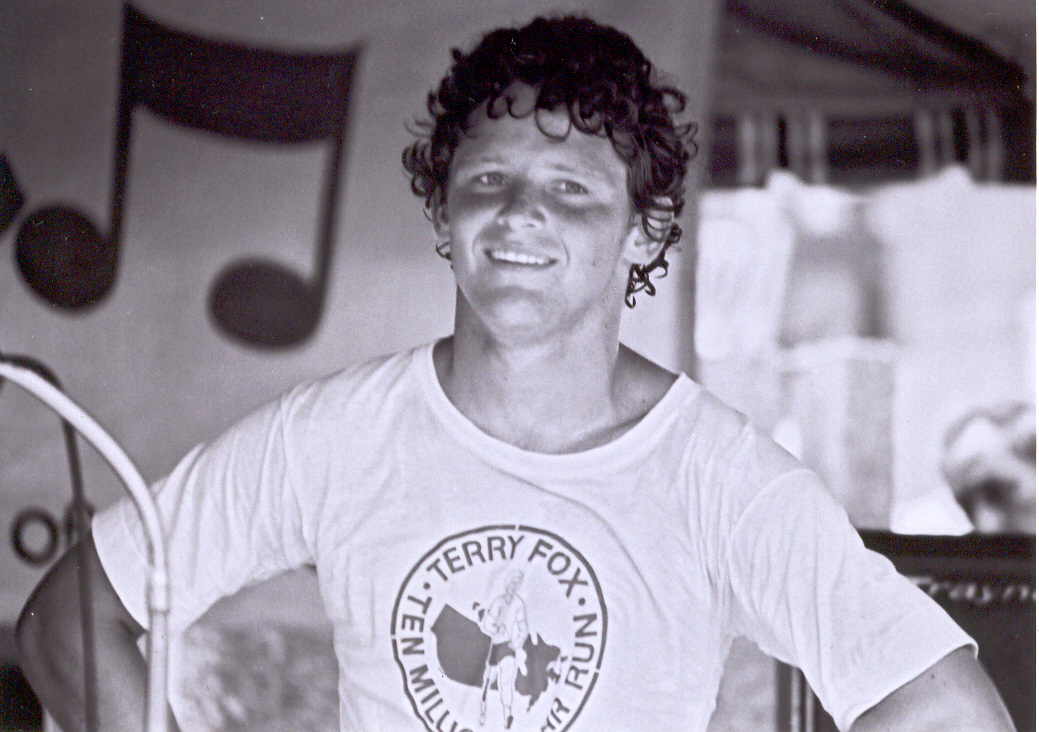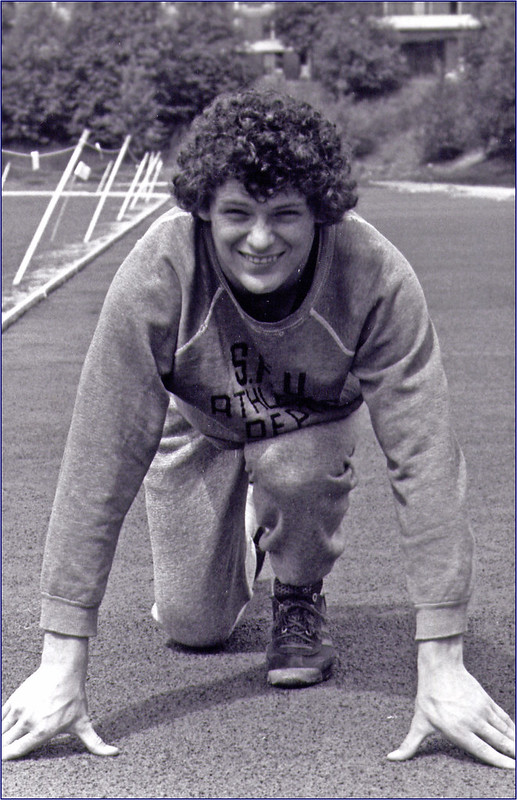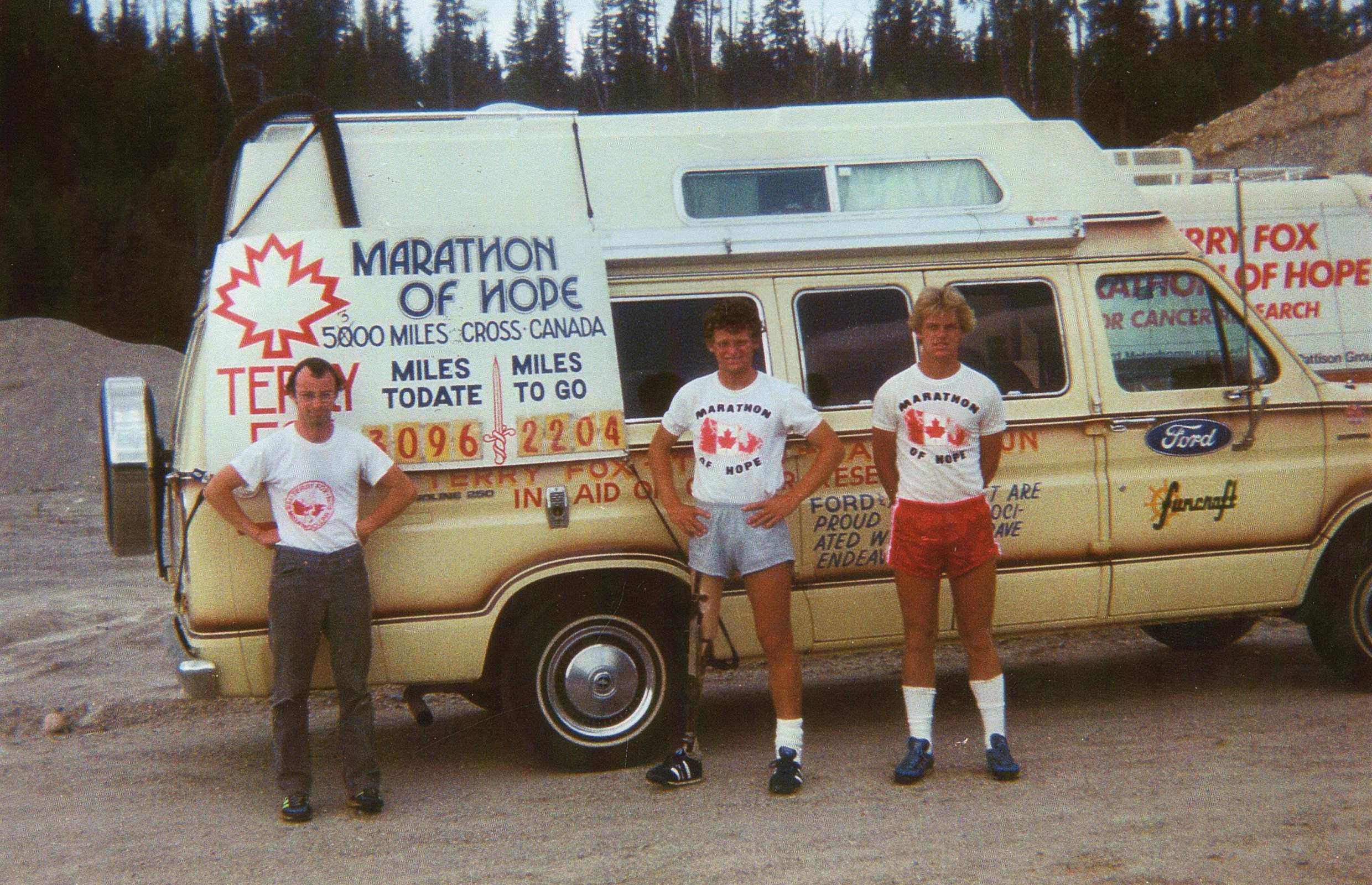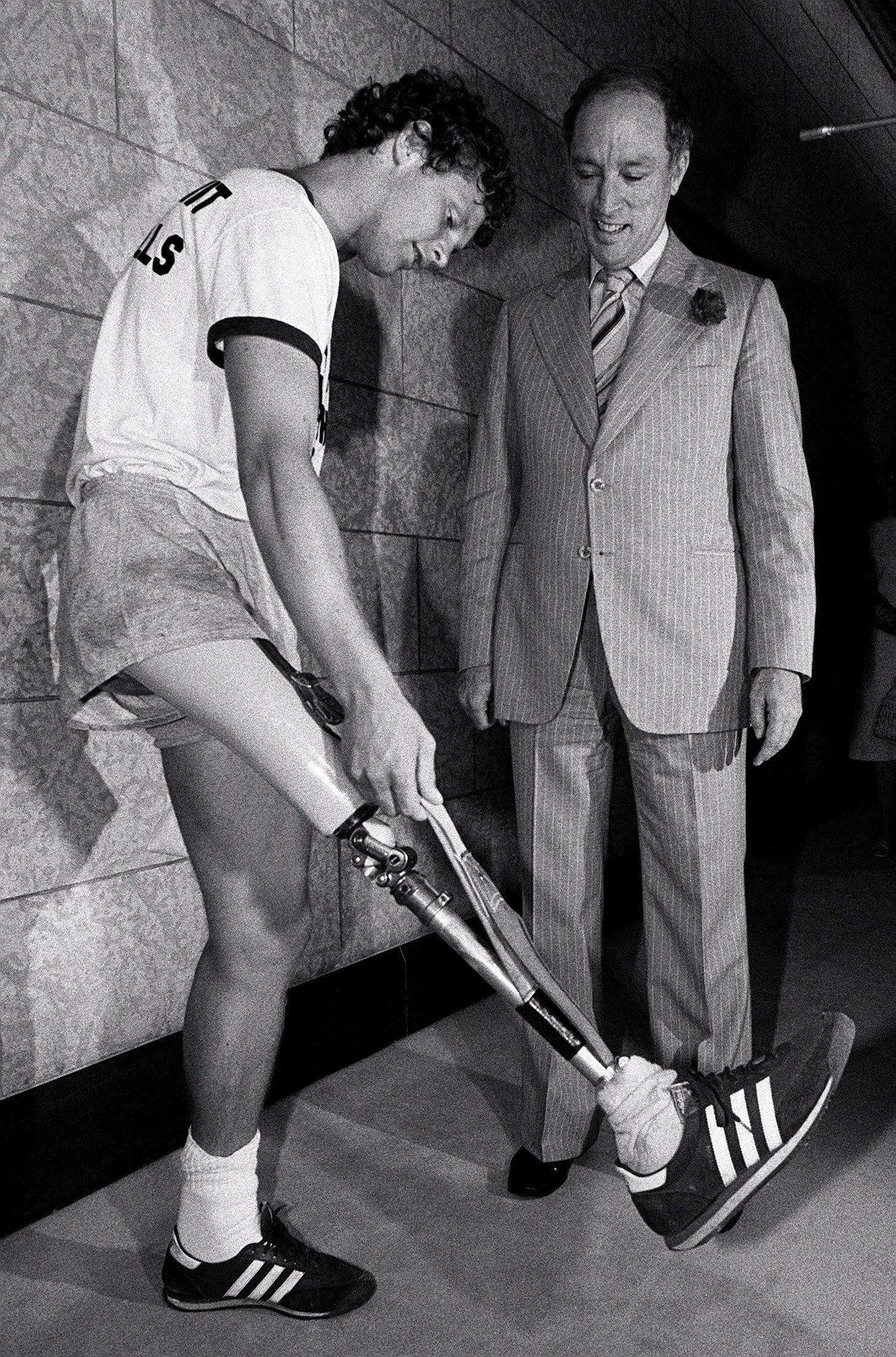Terrance Stanley Fox, CC, Order of the Dogwood, athlete, humanitarian, cancer research activist (born 28 July 1958 in Winnipeg, MB; died 28 June 1981 in New Westminster, BC). After losing his right leg to cancer at age 18, Terry Fox decided to run across Canada to raise awareness and money for cancer research. With the use of a customized running prosthesis, he set out from St. John’s, Newfoundland, on 12 April 1980 and covered 5,373 km in 143 days — an average of 42 km (26 miles) per day. He was forced to stop his Marathon of Hope in Thunder Bay, Ontario, on 1 September 1980, when cancer had invaded his lungs. He died shortly before his 23rd birthday. The youngest person to be made a Companion of the Order of Canada, he was awarded the 1980 Lou Marsh Trophy (now the Northern Star Award) as Canada’s athlete of the year and was named a Person of National Historic Significance by the Government of Canada. He was inducted into Canada’s Sports Hall of Fame and has had many schools, institutions and landmarks named in his honour. The annual Terry Fox Run has raised more than $800 million for cancer research. The Marathon of Hope raised $24 million by February 1981.

Early Life
Terry Fox was the second of four children born to Betty and Rolly Fox. Rolly was a switchman with the Canadian National Railway and met Betty in Winnipeg. All four of their children were born there: Fred (1957), Terry (1958), Darrell (1962) and Judith (1965). Tired of the harsh Winnipeg winters, Rolly transferred to Vancouver, British Columbia, in 1966. The family moved west and eventually settled in Port Coquitlam, a suburb east of Vancouver.
Early Athletics
Terry Fox was very determined from a young age, especially when it came to sports. In Leslie Scrivener’s biography, Terry Fox: His Story, she describes how, as an elementary school student, he was so committed to making baseball practice that he would arrive at the corner an hour early for his ride.
By the time he was in junior high school, basketball had become his favourite sport. Although he was only five feet tall in Grade 8 and had little natural ability, Fox was determined to make his school basketball team. His best friend, Doug Alward, also loved basketball and was a natural, playing on the first string of the Mary Hill Junior High Cobras. Bob McGill, their coach, suggested that Terry try cross-country running and wrestling instead. Fox did take up running but did not give up on his dream of playing basketball. He practiced every morning before school and throughout the summer. In Grade 8, he was last on the team’s lineup and only played one minute all season. By Grade 10, he and Alward were starting guards on the Mary Hill Junior High team. They also shared the school’s Athlete of the Year Award.
The following year, Fox was again chosen as a starting guard, this time with the Port Coquitlam High School Ravens. He also ran cross-country, and played soccer and rugby; and was co-winner (with Alward) of the school’s Athlete of the Year Award in Grade 12. By that time, Fox was the better basketball player, while Alward had become an accomplished cross-country runner. Fox’s determination and dedication were again recognized at Simon Fraser University (SFU), where he made the school’s junior varsity basketball team.

Terry Fox in his first year as a kinesiology student at Simon Fraser University.
Diagnosis and Surgery
Terry Fox first noticed the pain in his leg in 1976. In November of that year, he rear-ended a truck while driving on the highway — the car was a wreck, but Fox escaped without visible injury. The only problem was a sore right knee, which Fox assumed he must have hurt during the crash. The pain returned in December, but this time Fox believed it was a cartilage problem due to the stress of playing so much basketball. In February 1977, following the end of basketball season, he finally went to the SFU health centre, where he was given painkillers.
In early March, Fox returned from a training run in incredible pain, so sore he could barely move. The following day he went to a family doctor, who suspected the problem was serious. Rolly Fox drove his son to the Royal Columbian Hospital in New Westminster, where they were quickly seen by an orthopedic surgeon, Dr. Michael Piper. From the X-rays, Piper suspected that Fox had osteogenic sarcoma, a type of bone cancer that often starts in the knee. His suspicions were confirmed following a bone scan on 4 March. Because the cancer spreads quickly, doctors felt Fox’s best chance for survival was amputation of his right leg, followed by chemotherapy.
Over the next few days, Fox was surrounded by family and friends, including Doug Alward. Fox’s classmates from the kinesiology program at SFU brought his homework to the hospital. Teammates stopped in to visit, as did Terri Fleming, Fox’s basketball coach from Port Coquitlam High School. The night before his surgery, Fleming gave Fox a Runner’s World article about Dick Traum, an amputee who had run the New York City Marathon. The following morning, Fox showed the article to nurse Judith Ray. “Someday I’m going to do something like that,” he told her.
On 9 March 1977, when Fox was only 18, doctors amputated his right leg 15 cm above the knee.
Rehabilitation and Chemotherapy
Within weeks of his surgery, Fox was walking with the help of an artificial leg. Less than a month later, he was playing golf with his father. In addition to physiotherapy, Fox began a 16-month program of chemotherapy at the British Columbia Cancer Control Agency in Vancouver. Every three weeks he would visit the clinic, where he was given methotrexate and adriamycin. The drugs caused his hair to fall out and made him nauseous. Yet despite his suffering, he felt fortunate compared to others at the clinic, some of whom were dying. Not only did he feel compassion for them, but also a sense of responsibility that came with being one of the survivors.
Wheelchair Basketball
In the summer of 1977, Fox received a phone call from Rick Hansen, who asked if he would like to join the Vancouver Cable Cars wheelchair basketball team. As with everything he did, Fox practiced hard, his hands blistered and bleeding as he learned a different way to play basketball, all while undergoing chemotherapy. By the end of the summer, he had been chosen for the team that would compete at the 1977 national wheelchair basketball championships. Fox played with the Cable Cars from 1977 to 1980, winning the national championship in 1978 and 1979.
In the 1979–80 season, Fox was chosen for the all-star team of the North American Wheelchair Basketball Association. By that point he was playing three nights a week, using a wheelchair given to him as a gift by his father’s co-workers at Canadian National Railway. He would also train in his wheelchair along roads and pathways; not content with level surfaces, he climbed both Westwood and Burnaby Mountain in his wheelchair.

The Dream
But Fox had another goal. During his months of chemotherapy, he witnessed the suffering of many others afflicted with cancer and was determined to do something to help. On the night before his surgery, he had read an article about Dick Traum, an amputee who had run the New York City Marathon; inspired by Traum’s example, Fox decided he would run across Canada to raise awareness and funds for cancer research.
When Fox first started training, he ran at night around the cinder track at the local junior high school. In mid-February 1979 he could run half a mile around the track; by the end of the month he was running a mile. His prosthetist, Ben Speicher, modified his prosthesis so that it could better withstand the impact of running. (See Terry Fox and the Development of Running Prostheses.) Even with the modifications, though, it was still awkward and uncomfortable. Characteristically, Terry persisted.
By mid-August, he was preparing for a race in Prince George, British Columbia. Although he had originally planned to run in the eight-and-a-half-mile race, Fox ended up running the 17-mile (27 km) version with friend Doug Alward and brother Darrell. Terry finished last — but only 10 minutes behind the final two-legged runner.

The Plan
The Prince George race convinced Fox that he could start his run across Canada the following spring. With a start date in mind, it was time to tell his parents of his plan; until that point, only Alward and another friend, Rika Noda, had known anything about it. His mother, Betty, thought he was crazy. His father simply asked when he planned to start.
By the time Fox began his Marathon of Hope in April 1980, he had logged more than 5,000 km on training runs. He had also enlisted the support of the Canadian Cancer Society and the War Amputations of Canada, as well as companies including Ford Motor Company, Imperial Oil and Adidas.

Terry Fox's letter to the Canadian Cancer Society sums up his motivation for the Marathon of Hope:
The night before my amputation, my former basketball coach brought me a magazine with an article on an amputee who ran in the New York Marathon. It was then I decided to meet this new challenge head on and not only overcome my disability, but conquer it in such a way that I could never look back and say it disabled me.But I soon realized that that would only be half my quest, for as I went through the 16 months of the physically and emotionally draining ordeal of chemotherapy, I was rudely awakened by the feelings that surrounded and coursed through the cancer clinic. There were faces with the brave smiles, and the ones who had given up smiling. There were feelings of hopeful denial, and the feelings of despair. My quest would not be a selfish one. I could not leave knowing these faces and feelings would still exist, even though I would be set free from mine. Somewhere the hurting must stop... and I was determined to take myself to the limit for this cause.
…By next April I will be ready to achieve something that for me was once only a distant dream reserved for the world of miracles – to run across Canada to raise money for the fight against cancer.
The running I can do, even if I have to crawl every last mile.
We need your help. The people in cancer clinics all over the world need people who believe in miracles.
I am not a dreamer, and I am not saying that this will initiate any kind of definitive answer or cure to cancer. But I believe in miracles. I have to.
Terry Fox, October 1979

Marathon of Hope
Fox began his cross-country Marathon of Hope on 12 April 1980, dipping his artificial leg in the Atlantic Ocean near St. John’s, Newfoundland. It was a cold, wet start to his epic journey.
On average, Fox would run about 42 km (roughly a marathon) a day through the Atlantic Provinces, Quebec and Ontario. He was supported by long-time friend Doug Alward, who drove a van along the route, and by his brother, Darrell, who joined them in New Brunswick. The tension between Terry and Doug could get high at times, but Darrell was usually able to lighten the mood.
While media coverage was slow at first, communities in Newfoundland such as Grand Falls and Bishop’s Falls came out to support Fox. However, he was disappointed by their early reception in Nova Scotia, as few people in the province seemed to know about his Marathon of Hope. According to Fox’s diary, Prince Edward Island was more hospitable. He was disappointed again, though, to learn nothing had been arranged for them in Saint John, New Brunswick. He and Alward decided to run through the city, anyway. It was even tougher in Quebec — the Marathon of Hope had not been publicized in the province, and he raised almost no money there.

That changed, however, due to the efforts of businessman Isadore Sharp, Bill Vigars of the Canadian Cancer Society’s
Ontario division and journalist Leslie Scrivener of the Toronto Star. Scrivener wrote a weekly column on Fox’s progress (and later penned his biography).
By the time he reached Ontario, Fox was a national star, feted by thousands at appearances organized by the Canadian Cancer Society. Fox met Prime Minister Pierre Trudeau, British actress Maggie Smith, and NHL greats Bobby Orr and Darryl Sittler, who presented Fox with a 1980 NHL All-Star sweater. Despite the crowds, it was also safer running in Ontario; on several occasions, Fox had come close to being hit by cars or trucks while running across the Atlantic Provinces and Quebec. In Ontario, the provincial police accompanied him.
However, Fox was forced to stop running just outside Thunder Bay, Ontario, on 1 September 1980, because the cancer had invaded his lungs. By this time, he had run for 143 days and covered 5,373 km — the equivalent of more than 128 marathons. Fox vowed he would complete his cross-Canada run, but he was unable to return.

After the Marathon of Hope
By the time Fox halted his run, his efforts had galvanized the country. On 7 September 1980, CTV aired a telethon that raised $6.5 million in five hours, pushing the total amount raised by the Marathon of Hope to $10 million. Less than two weeks later, Fox became the youngest person ever to be made a Companion of the Order of Canada, the country’s highest civilian honour. He was also presented with the Order of the Dogwood (the precursor of the Order of British Columbia), the province’s highest civilian honour. In December, he was named Newsmaker of the Year by the Canadian Press and won the Lou Marsh Trophy as Canada’s Athlete of the Year.
On 1 February 1981, Fox achieved his goal of raising $1 for every person in Canada when the donations topped $24.17 million (Canada’s population at the time was approximately 24.1 million). In early June, Simon Fraser University bestowed upon Fox the inaugural Terry Fox Gold Medal. It is awarded annually to “an SFU student who has demonstrated courage in the face of adversity and possesses qualities becoming of a role model.”
After undergoing months of treatment for cancer, Terry contracted pneumonia in June 1981 and went into a coma on 27 June. He died at Royal Columbian Hospital in New Westminster 4:35 a.m. on 28 June, one month before his 23rd birthday. Flags across the country were flown at half-mast. Addressing the House of Commons that day, Prime Minister Pierre Trudeau said, “It occurs very rarely in the life of a nation that the courageous spirit of one person unites all people in the celebration of his life and in the mourning of his death.” Trudeau expressed, on behalf of all Canadians, “our profound gratitude for the gift which Terry gave to all of us, the gift of his own boundless courage and hope.”

Honours
Terry Fox received many more honours following his death. In the summer of 1981, the federal government established a $5 million endowment in Terry’s name to provide scholarships to young Canadians, and Canada’s Sports Hall of Fame posthumously inducted him in the Honourary Member category. The Canadian Press named Fox the Newsmaker of the Year for the second year in a row, and in April 1982, Canada Post issued a stamp in Terry’s honour, foregoing its rule to wait at least 10 years after a person’s death before so honouring them. In June 1982, a monument featuring a 2.7 m bronze statue of Terry Fox was unveiled near where he ended his Marathon of Hope outside Thunder Bay.
Many schools, buildings, roads and parks around the country have been named in Fox’s honour, including a provincial park and a mountain in British Columbia. BC, Manitoba and Ontario have all declared an annual Terry Fox Day in his honour. On Canada Day in 1999, Fox was named Canada’s greatest hero in a national survey, and in 2004, he was ranked second after Tommy Douglas in the CBC Television program The Greatest Canadian. In April 2005, the Royal Canadian Mint issued a commemorative one dollar coin to mark the 25th anniversary of the start of the Marathon of Hope.
At the 2010 Olympic Winter Games in Vancouver, Terry’s mom, Betty Fox, served as one of eight flag bearers who carried the Olympic flag during the opening ceremonies. The Vancouver Olympic Organizing Committee also presented figure skater Joannie Rochette and cross-country skier Petra Majdic with the Terry Fox Award, for “showing determination and humility in the face of obstacles.”
In 2012, Terry Fox was inducted into the Canadian Medical Hall of Fame in the Builder category for his efforts in raising money for cancer research. A bronze statue commemorating the moment Fox dipped his leg in the ocean in St. John’s, Newfoundland, was also unveiled near the exact spot where it happened. In 2013, Fox was posthumously inducted into Canada’s Walk of Fame in Toronto. In 2015, the Canadian Museum of History launched an exhibit about the Marathon of Hope, “Running to the Heart of Canada,” which travelled across the country until 2019.
Métis Heritage
Terry Fox had Métis heritage through his mother’s side of the family. Betty Fox (née Wark) was the daughter of John Wark and Marian Gladue, whose own great-grandmother, Madeleine Poitras, was Métis. However, Gladue was reluctant to discuss this aspect of her background, and the family did not realize they had Métis heritage until after her death in 2001. Many of the family have since proudly declared their heritage, including Terry’s brother, Darrell. Métis Nation British Columbia (MNBC) has confirmed his status and that of his daughter, Alexandra. In 2014, MNBC posthumously awarded the Order of the Sash to Terry Fox, “in recognition of his contribution and sacrifice to our nation, and for giving so much of himself in the name of human kindness.”
Legacy
Fox’s story has been told in books, television movies — the Genie Award-winning The Terry Fox Story (1983) and Terry (2005) — and in a Heritage Minute. The ESPN documentary “Into the Wind” (2010) was co-directed by NBA star Steve Nash, who has called Fox his personal hero.
Fox’s goal to raise one dollar for every Canadian, or about $24 million, was reached on 1 February 1981. Since then, fundraising has continued in his name. His bravery and determination have inspired many, including Steve Fonyo, Rick Hansen and Isadore Sharp, who organized the first annual Terry Fox Run in 1981. Millions of people in Canada and around the world participate every year in the Terry Fox Run. The Terry Fox Foundation, which is overseen by Fox’s family and organizes the annual run, has raised more than $800 million for cancer research. The Terry Fox Research Institute in Vancouver, which “invests in world-class, collaborative cancer research teams and partnerships,” was founded in 2007.
(See also: Terry Fox: Role Model and Inspiration; The Courage of Terry Fox; Terry Fox and the Development of Running Prostheses; 25th Anniversary of Terry Fox’s Marathon of Hope.)
Awards
- Companion, Order of Canada (1980)
- Member, Order of the Dogwood (1980)
- Lou Marsh Trophy (now the Northern Star Award) (1980)
- Newsmaker of the Year, Canadian Press (1980, 1981)
- Inductee, Canada’s Sports Hall of Fame (1981)
- Person of National Historic Significance, Government of Canada (2009)
- Inductee, Canadian Medical Hall of Fame (2012)
- Inductee, Canada’s Walk of Fame (2013)
- Order of the Sash, Métis Nation British Columbia (2014)

 Share on Facebook
Share on Facebook Share on X
Share on X Share by Email
Share by Email Share on Google Classroom
Share on Google Classroom



